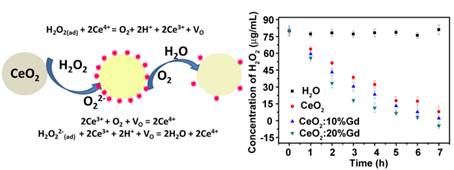Due to their excellent anti-oxidation performance, CeO2 nanoparticles receive wide attention in pharmacological application. Deep understanding of the anti-oxidation mechanism of CeO2 nanoparticles is extremely important to develop potent CeO2 nanomaterials for anti-oxidation application. However, the anti-oxidation mechanism of CeO2 nanoparticles has remained elusive. A joint team (Rare Earth Separation and Inorganic Materials of Beijing University and Laboratory of Energy Storage and Conversion of Huazhong University of Science and Technology) has gained insight into the anti-oxidation mechanism and modulation of anti-oxidation performance. Their research has been published on July 3rd, 2015 in Nanoscale.
This work was devoted to the study on the anti-oxidation mechanism and modulation of anti-oxidation performance of CeO2 nanoparticles. On this basis, this work also studied the anti-oxidation protection application of CeO2 nanoparticles in INS-1 cells. The UV-Vis absorption of CeO2 nanoparticles shifts to red after the addition of H2O2 and the shift extent increases with the concentration of H2O2. Meanwhile, the coordination number of Ce increases after the addition of H2O2, and recovers back to near the initial value as the reaction proceeds. In addition, adsorbed peroxides species are detected during the anti-oxidation process, which are responsible for the red-shifted absorption spectra of CeO2 nanoparticles. On the basis of these results, the reactivity of coordination sites for peroxides species is considered to play as a key role in the anti-oxidation performance of CeO2 nanoparticles. In addition, in this work, the anti-oxidation performance of CeO2 nanoparticles can be enhanced after Gd3+ doping due to the enhanced coordination and reducibility.
X-ray absorption fine structure analysis (XAFS) can be contributed to the study on the anti-oxidation mechanism. Using synchrotron radiation at BSRF, this work monitored the valence and coordination structure of Ce ions during the anti-oxidation reaction in order to reveal the anti-oxidation mechanism of CeO2 nanoparticles. The main valence state of Ce in the sample as determined by XAFS is +4. Meanwhile, the coordination number of Ce increases after the addition of H2O2, and recovers back to near the initial value as the reaction proceeds. On the basis of these results, peroxide species are proposed to be able to coordinate with surface Ce ions and decompose because of the intrinsic redox ability of Ce3+/Ce4+ pair.

The research provides the scientific community clues to understand the anti-oxidation mechanism and modulation of anti-oxidation performance of CeO2 nanoparticles. Synchrotron sources have helped the team to unveil the change of coordination structure of Ce sites of CeO2 nanoparticles. Prof. Chunhua Yan of Beijing University has been working on the controllable synthesis and catalytic mechanism of CeO2 nanoparticles. Synchrotron sources can help to reveal the structure-function relationship of CeO2 nanomaterials as catalysts.
Article:
Yan-Jie Wang, Hao Dong, Guang-Ming Lyu, Huai-Yuan Zhang, Jun Ke, Li-Qun Kang, Jia-Li Teng, Ling-Dong Sun,* Rui Si, Jing Zhang, Yan-Jun Liu,* Ya-Wen Zhang, Yun-Hui Huang* and Chun-Hua Yan*, Engineering the defect state and reducibility of ceria based nanoparticles for improved anti-oxidation performance, Nanoscale, 2015, 7, 13981-13990.


